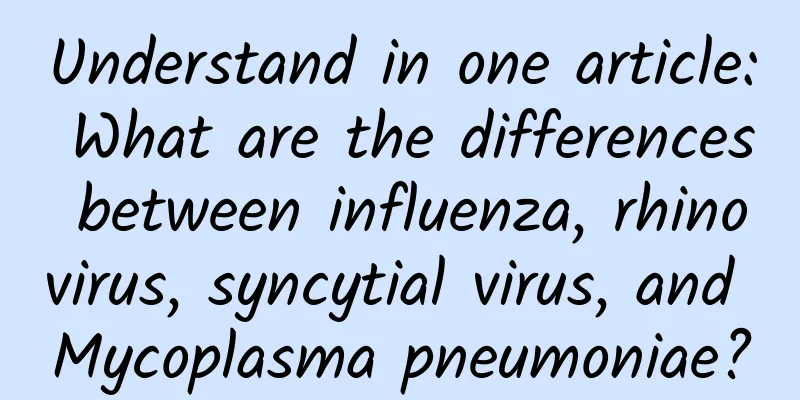Understand in one article: What are the differences between influenza, rhinovirus, syncytial virus, and Mycoplasma pneumoniae?

|
November is drawing to a close, and respiratory infectious diseases are still at a high incidence. Recently, Wang Quanyi, deputy director of the Beijing Center for Disease Control and Prevention and chief epidemiologist, said in an interview with the Beijing Daily that the prevalence of Mycoplasma pneumoniae has dropped to fourth place among children's respiratory infectious diseases. According to the results of respiratory pathogen monitoring, the top three reported cases of respiratory infectious diseases in the entire population of Beijing are influenza, rhinovirus, and respiratory syncytial virus . We may be more familiar with "influenza" and relatively unfamiliar with rhinovirus and respiratory syncytial virus. In fact, they are also common pathogens in respiratory infections. In this issue of Health Focus, let's take a look at the similarities and differences between them! 1. Characteristics of pathogens >>Influenza virus The acute respiratory infectious disease caused by influenza virus is called influenza, or flu for short. Influenza virus is a kind of RNA virus, which can be divided into four types: A, B, C, and D. Among them, type A and type B are the most notorious. They cause the well-known "influenza A" and "influenza B". It is easy to mutate and highly contagious. Influenza virus is sensitive to common disinfectants such as ethanol, iodine tincture, etc. It is sensitive to ultraviolet light and heat, and can be inactivated at 56°C in 30 minutes. >> Rhinovirus Rhinovirus is the most common pathogen of human viral respiratory infection and is prevalent worldwide. About 30% to 50% of colds in adults and children are caused by rhinovirus infection . The optimal temperature for its survival is between 33°C and 35°C. Because the nasal cavity is exposed to the cold air outside, the temperature is lower than the body temperature, which is exactly what rhinovirus likes. Therefore, they usually gather in the nose and cause nasal symptoms, so they are called rhinovirus. It is easily inactivated in acidic and high temperature conditions. >>Respiratory syncytial virus Respiratory syncytial virus is an RNA virus belonging to the Pneumoviridae family and the Orthopneumovirus genus. The virus incubation period is about 2-8 days, and the virus shedding period (which can be simply understood as the time interval from the first positive test to the last positive test) is generally 3 to 7 days, but in infants and young children it is as long as 2 to 3 weeks, so respiratory syncytial virus is more likely to spread in infants and young children , and most children have been infected before the age of 2. Acute lower respiratory tract infections caused by respiratory syncytial virus are more common in young children. >>Mycoplasma pneumoniae Mycoplasma pneumoniae is neither a bacterium nor a virus . It is a microorganism between the sizes of bacteria and viruses, with a volume less than 5% of the average volume of bacteria. It has no cell wall structure, like a bacterium without a "coat". It is highly contagious and has a long incubation period (1-3 weeks). It is contagious during the incubation period until the symptoms are relieved for several weeks. 75% alcohol and chlorine-containing disinfectants (such as 84 disinfectant) can kill Mycoplasma pneumoniae. 2. Transmission channels Influenza, rhinovirus, respiratory syncytial virus, and Mycoplasma pneumoniae are mainly transmitted through droplets and contact . They may also be transmitted through aerosols in crowded, closed, or poorly ventilated rooms, so be vigilant. 3. Symptoms and characteristics of the disease Common points: All may experience symptoms of upper respiratory tract infection such as fever, cough, nasal congestion, and runny nose. Differences: >>Influenza virus The symptoms are relatively severe, with sudden high fever , chills, and shivering, often accompanied by body aches, fatigue, nausea, vomiting, lack of energy, and other systemic symptoms. Young children may not express themselves clearly, so parents should pay attention to the fact that their children's mental state is different from before. Infants may become listless, not eat properly, or even move less. >> Rhinovirus The main symptoms are upper respiratory tract infection such as nasal congestion, runny nose, sneezing, etc. The lower respiratory tract is rarely affected, so symptoms such as runny nose and cough are generally mild, with or without fever. Infants or children with some underlying diseases (such as asthma, congenital heart disease, etc.) will become more seriously ill after being infected with rhinovirus. They may develop lower respiratory tract infections such as bronchitis and pneumonia. If combined with other pathogen infections, the clinical symptoms may worsen. >>Respiratory syncytial virus The main symptoms in the early stages of infection include fever, nasal congestion, runny nose, cough, and hoarseness. Most of the symptoms of infected children will disappear within 1-2 weeks, and a small number of them may develop lower respiratory tract infections. It is particularly important to note that the younger the infected person is, the more obvious the symptoms are. For example, children under 2 years old are more likely to develop lower respiratory tract infections, such as bronchiolitis or pneumonia. A very small number of cases will further develop into shortness of breath, labored breathing, and difficulty feeding. Severe cases may develop into respiratory failure. >>Mycoplasma pneumoniae The fever is mainly moderate to high, and persistent high fever indicates a serious condition. The cough is more severe and irritating and dry . Some children have wheezing, which is more common in infants and young children. A small number of patients may also develop extrapulmonary complications, such as autoimmune hemolytic anemia. Lazy mode in this section: How to treat Common points: ① Monitor body temperature well. If high fever occurs, physical cooling and antipyretic drugs should be used in time. ② For those with severe respiratory irritation symptoms, symptomatic treatment can be given, such as giving cough suppressants and expectorants, percussing to expel sputum, etc. ③ If you experience persistent fever, high fever, severe cough, wheezing, etc., it is recommended to seek medical attention promptly. Note: Specific medications must be used under the guidance of a clinician. Differences: >>Influenza virus Commonly used antiviral drugs include oseltamivir, zanamivir and intravenous peramivir. The best time to give the drug is within 48 hours of the onset of flu symptoms, which can reduce complications. Giving the drug 96 hours after the onset of symptoms is also effective. >> Rhinovirus Rhinovirus infection is self-limiting and generally heals in about a week . No special treatment is required. It is not recommended to take antibiotics on your own. >>Respiratory syncytial virus At present , there are no specific antiviral drugs and treatments for respiratory syncytial virus infection in China. Generally, symptomatic treatment such as conventional antiviral drugs such as Chinese patent medicines and cough and expectorant drugs can improve the condition, but if symptoms such as cough, shortness of breath and difficulty breathing occur, medical treatment should be sought promptly. >>Mycoplasma pneumoniae Symptoms of M. pneumoniae pneumonia are generally mild and usually resolve on their own. Macrolide antibiotics are the first choice in clinical practice, including azithromycin, clarithromycin, erythromycin, roxithromycin, etc. For patients with severe cough that significantly affects their rest, antitussive drugs can be given according to the situation. 5. How to prevent Common points: An important means of prevention is to maintain good personal hygiene habits . The main measures include: ① Wash your hands frequently, keep the environment clean and ventilated, minimize activities in crowded places during epidemic seasons, and avoid contact with patients with respiratory infections; ② Maintain good respiratory hygiene habits. When coughing or sneezing, cover your mouth and nose with your upper arm or a tissue or towel. Wash your hands after coughing or sneezing, and try to avoid touching your eyes, nose or mouth. ③ If symptoms occur, you should rest and self-isolate, and wear a mask when going to public places or seeking medical treatment. Differences: Influenza vaccination is the most effective way to prevent influenza . It is recommended that key groups such as the elderly, infants, children, and pregnant women receive timely vaccination. Currently, there is no vaccine in China that can prevent rhinovirus, respiratory syncytial virus, and Mycoplasma pneumoniae infections. Special reminder: There are many cases of mixed infection and successive infection with multiple pathogens, so don't let your guard down. If a child has a persistent fever for more than 3 days, or has been in a persistent high fever, is in a very bad mental state; has frequent coughing that affects daily life; has increased breathing speed and difficulty breathing; a baby has a shortness of breath, an ugly face, a pale face, or frequent vomiting, decreased urine volume, frequent diarrhea, etc., you must seek medical attention immediately. This article focuses on refining the |
>>: Photovoltaic, born towards the sun, will be the leader in renewable energy power in 2050!
Recommend
Introduction to the advantages of Baidu promotion knowledge marketing advertising resources!
What is knowledge marketing? Answer: Knowledge ma...
OPPO Smart TV K9 65-inch review: One billion colors, a powerful player that cannot be ignored
If we say that last year OPPO was still testing t...
Interpretation of China Unicom's "Hang Fei Bao": Buying an iPhone is a good deal
On May 20, Shenzhen Unicom and Essence Fund jointl...
What is it like to have a girlfriend who works in new media?
Now there is a profession called new media people...
0 to 3 years old baby early education game video tutorial Baidu cloud download
0 to 3 years old early childhood education game v...
Advertising spending rankings in October 2016 (with analysis)
The latest research from CTR Media Intelligence s...
Ministry of Industry and Information Technology: Operation status of the national lithium-ion battery industry in 2022
In 2022, my country's lithium-ion battery ind...
The developer website was accidentally launched, and Android 11 may provide these features
The login page of the Android 11 developer websit...
Silicon Valley debut? LeEco's mobile phone has the possibility of entering the international market
The long-awaited LeTV Super Phone has undoubtedly...
Uncle Lei's "Data-based Operations in Action"
In the data age, whether it is product, operation...
9 practical methods behind new media operations of popular headlines!
It is said that a good title is half the battle o...
The “Pinduoduo-style” copywriting trick is repeated, what is the effect?
On November 11, 2016, Pinduoduo's single-day ...
These 10 little things are not selfish even if you do them!
We have been taught since childhood not to be &qu...
Is it a loss if you don’t buy anything on 618?
Part 1 618 has arrived Dear, has the hand that wa...









